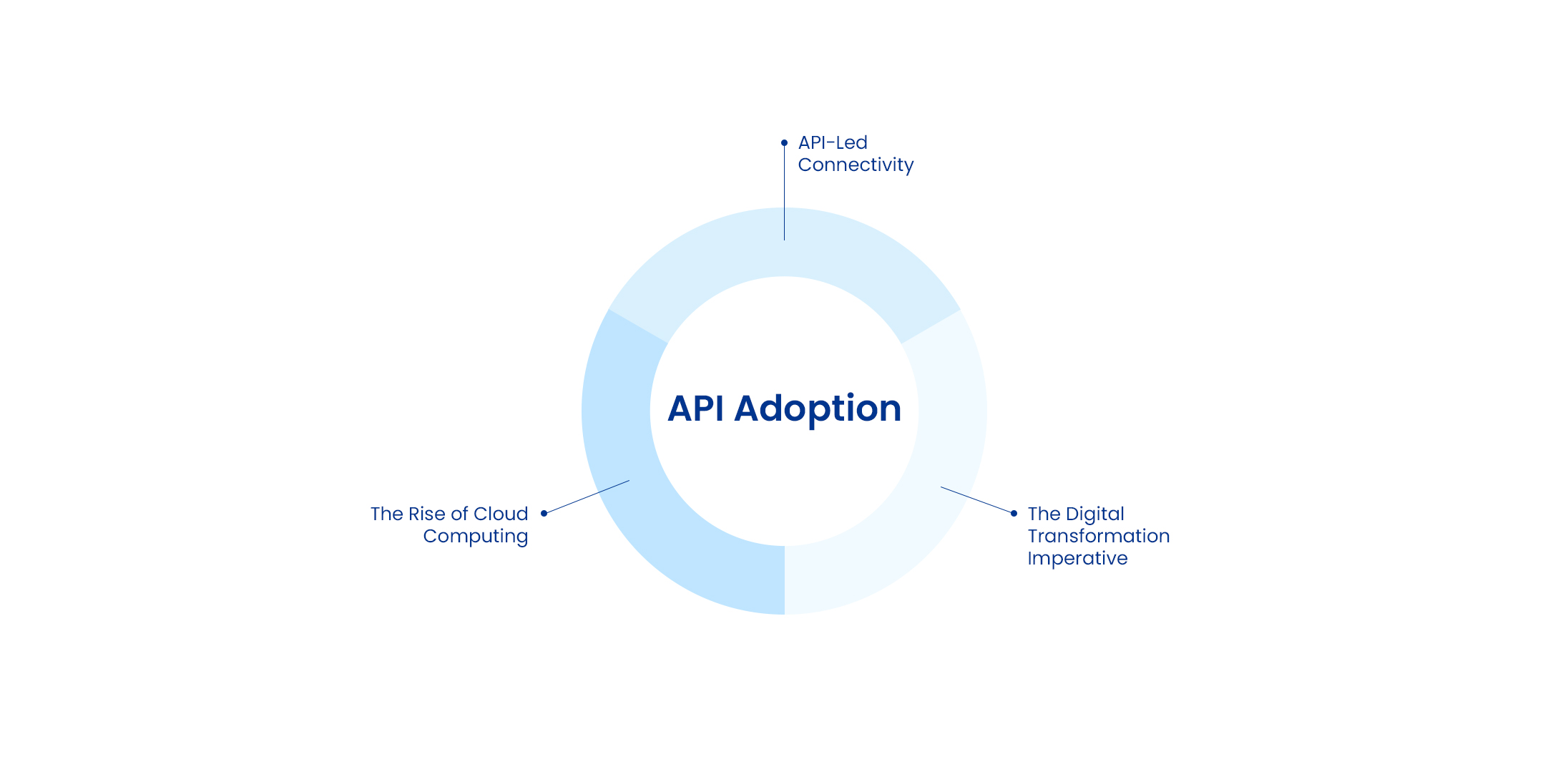
Everything You Need to Know about API Adoption
Businesses must evolve and innovate to stay competitive in the ever-growing market. API adoption has witnessed an extraordinary surge across industries. Over 85% of enterprises are already using APIs or are in the process of doing so, a testament to how APIs are integral to defining business operations.
APIs act as messengers, enabling different software applications to talk to each other and share data. Businesses can create a unified data architecture by integrating applications through API adoption. API adoption can also help organizations improve customer experience, automate tasks to increase efficiency and drive innovation through easy access to data.
The Rise of API Adoption
Businesses are taking advantage of the opportunity to get on the API bandwagon, and this rapid increase in API adoption involves several pressing needs enterprises face. These needs include data integration, automation, and real-time data access. Companies hope to achieve efficiency and innovation by incorporating and adopting APIs into their operations.
Breaking Down Data Silos
Traditional software applications create data silos. Valuable information gets trapped within individual systems, making gaining a holistic view of the business complex. APIs act as intermediaries, allowing seamless communication and data exchange between applications. This exchange breaks down data silos and creates a unified data architecture.
A unified system allows organizations to have accessible data in one place, which makes data-driven decisions faster and more effective.
Real-Time Data Access
Many businesses need help with outdated or delayed data, which makes it difficult to react to changing market conditions or address customer needs in real-time. APIs enable real-time data exchange between applications.
With real-time access to customer information, businesses can personalize interactions and provide a more responsive experience. Real-time data allows companies to identify trends and opportunities quickly, enabling them to adapt to changing market conditions.
Streamlining Operations
Businesses rely on manual data entry and task completion processes, leading to inefficiencies like delays, wasted resources, and inaccurate data. APIs automate data exchange between systems, eliminating the need for manual data entry.
Automating tasks saves time and costs by reducing the need for additional personnel. By eliminating manual entry, businesses can lower the number of errors and ensure data consistency across all systems.
Driving Innovation
Traditional IT infrastructures can be inflexible and slow to innovate. Businesses using traditional infrastructure usually need help integrating technologies or experimenting with new ideas. APIs enable companies to combine the best solutions, helping them bring innovative products and services to market quicker.
Businesses can also easily update their technology stack as their needs evolve by integrating new solutions.
Key Factors Driving API Adoption

The widespread adoption of APIs is driven by influential trends shaping the industry. Let’s explore some key factors motivating businesses to adopt APIs:
The Rise of Cloud Computing
The cloud revolution has fundamentally transformed how businesses store, access, and manage data. Cloud-based applications offer scalability, flexibility, and cost-effectiveness for businesses of all sizes. However, integrating these cloud applications with existing on-premise systems can take time and effort. By providing standardized interfaces for communication, APIs enable seamless integration between cloud-based and on-premise applications, creating a unified digital ecosystem.
Benefits
- APIs simplify connecting cloud applications with existing systems, eliminating the need for custom coding and development efforts. This translates to faster implementation times and reduced costs.
- Cloud-based APIs offer inherent scalability, allowing businesses to quickly expand their infrastructure and integrate new applications as their needs evolve.
The Digital Transformation Imperative
Businesses across industries face growing pressure to transform their operations digitally to keep pace with evolving customer expectations and remain competitive. This transformation involves leveraging technology to improve efficiency, enhance customer experience, and drive innovation. APIs play a critical role in this process by acting as the connective tissue between various digital tools and data sources.
Benefits
- Customers now expect a seamless and personalized experience. APIs enable businesses to gather and analyze customer data from various sources, creating a 360-degree view of their customers and delivering personalized experiences across all touchpoints.
- Manual data entry and repetitive tasks consume time and cause errors. APIs eliminate manual work and reduce the need for additional personnel, directly translating to business cost savings.
API-Led Connectivity
Businesses increasingly adopt an “API-first” mindset, where APIs are integral to their digital strategy. API-led connectivity revolves around using APIs as the primary way to expose functionalities and data within an organization. This approach creates a more open and collaborative environment where businesses can connect with external partners, developers, and customers through APIs.
Benefits
- By opening data and functionalities through APIs, businesses can create new revenue streams by enabling third-party developers to build innovative solutions and services on their platforms.
- APIs allow businesses to extend their reach to new markets and customer segments by enabling third-party developers to integrate APIs with their platforms.
Strategies for Successful API Adoption
API adoption benefits organizations in various aspects but requires specific methodologies to achieve the required objective.
- Ensuring security requires verifying secure APIs, limiting access to authorized users, and encrypting data during transfers.
- Costs can be substantial, requiring careful planning and budgeting for development, integration, and maintenance.
- Clear, concise documentation makes your API user-friendly, specifying accessible data and usage instructions.
- Providing timely support is essential for addressing user questions and technical issues.
- Managing the API involves controlling access, addressing errors, and monitoring usage metrics.
Best Practices for Facilitating API Adoption
API adoption is a collaborative effort, so encouraging open communication and building a strong foundation for security are critical to a successful implementation strategy.
Define a Clear API Strategy
The foundation of any successful API adoption initiative rests on a well-defined strategy. The strategy serves as a roadmap, guiding a business’s efforts and ensuring everyone is aligned on goals. The strategy involves:
- Identify Business Objectives: What APIs do you need to develop, and how do you integrate them into your existing data structure?
- Inventory Existing Assets: Before starting API development, consider your current systems and data. This includes identifying applications, databases, and any existing APIs you have. Understanding your existing architecture helps you determine which functionalities and data can be exposed through APIs and how they will connect with other systems.
- Choose the Right APIs to Expose: Prioritize functionalities that offer the most outstanding value to external users or that can streamline internal processes. Focus on creating APIs that are well-defined, secure, and user-friendly.
- Establish Governance Guidelines: Define guidelines for API ownership, lifecycle management, versioning, and security protocols. These guidelines ensure a consistent and controlled approach to API development and deployment.
Foster a Collaborative Culture
API adoption results from an effective collaboration between IT and business teams.
- Align Business and IT Teams: Ensure both sides understand the business objectives behind API adoption and how APIs will contribute to achieving those goals.
- Educate Stakeholders: Organize training sessions to educate various stakeholders, including developers, business analysts, and product managers. Focus on explaining APIs and how they can be leveraged within the organization.
- Create Communication Channels: Establish open communication channels between IT and business teams to facilitate discussions on API design, integration needs, and potential challenges.
Invest in Developer Experience
Developers are the key players when it comes to building and utilizing APIs. You can take a few steps to ensure a positive developer experience:
- Invest in Documentation: Provide clear, concise, and up-to-date API documentation that includes code samples, tutorials, and troubleshooting guides.
- Develop Interactive API Sandboxes: Create interactive sandbox environments where developers can experiment with your APIs without impacting production systems.
- Offer Responsive Support: Establish support channels to answer developer questions, address technical issues, and provide feedback on API functionality.
Prioritize API Security
Security is essential when exchanging data through APIs, as insecure APIs expose sensitive data to unauthorized access, manipulation, or theft.
- Implement Authentication and Authorization: Utilize authentication mechanisms to verify user identities and authorization protocols to control access rights and limit exposure of sensitive data.
- Encrypt Data in Transit and at Rest: Secure data as it is transmitted between systems and stored at rest within your infrastructure.
- Regularly Monitor and Update Security Measures: Security threats constantly evolve, so it’s essential to periodically monitor API usage, identify potential vulnerabilities, and update security measures proactively.
Choose the Right Tools and Technologies
A variety of tools and technologies can streamline your API adoption process. They should offer certain functionalities;
- API Management Platform: Explore API management platforms that offer features for API design, development, deployment, and analytics. These platforms can simplify API management and provide valuable insights into API usage.
- API Testing Tools: Utilize automated API testing tools to ensure APIs function as expected and identify potential bugs before deployment.
- Version Control Systems: Implement version control systems to track changes to APIs and facilitate revert if necessary.
Continuously Monitor and Analyze
API adoption is an ongoing process; it is imperative to continuously monitor API usage metrics to understand how developers use your APIs and identify areas for improvement. Analyze performance data to ensure APIs are functioning efficiently and meeting user needs.
Conclusion
API adoption is an absolute necessity to excel in this competitive digital market. APIs enable your business to remain responsive to changing market scenarios by breaking down silos, enabling real-time data access, and streamlining operations. They empower you to connect with external partners and create a more dynamic and efficient digital network.
You can take substantial steps towards successful API adoption and integration by prioritizing developer experience, continuous security and choosing the right tools.
Speaking of the right tools, Astera is one of the leading API lifecycle management solutions. It is a unified platform that offers distinctive features for API design without the need to code. With its drag-and-drop interface, Astera automates API development and testing processes.
Contact us or schedule a demo to experience how Astera can tackle challenges and ease the API adoption process for you.
Ease Your Way Towards API Adoption with Astera
Take charge of your API integration with Astera’s intuitive platform. Simplify data management and enhance operational efficiency effortlessly. Download a free trial to experience the seamless API adoption.
Start a Free Trial Astera AI Agent Builder - First Look Coming Soon!
Astera AI Agent Builder - First Look Coming Soon!

